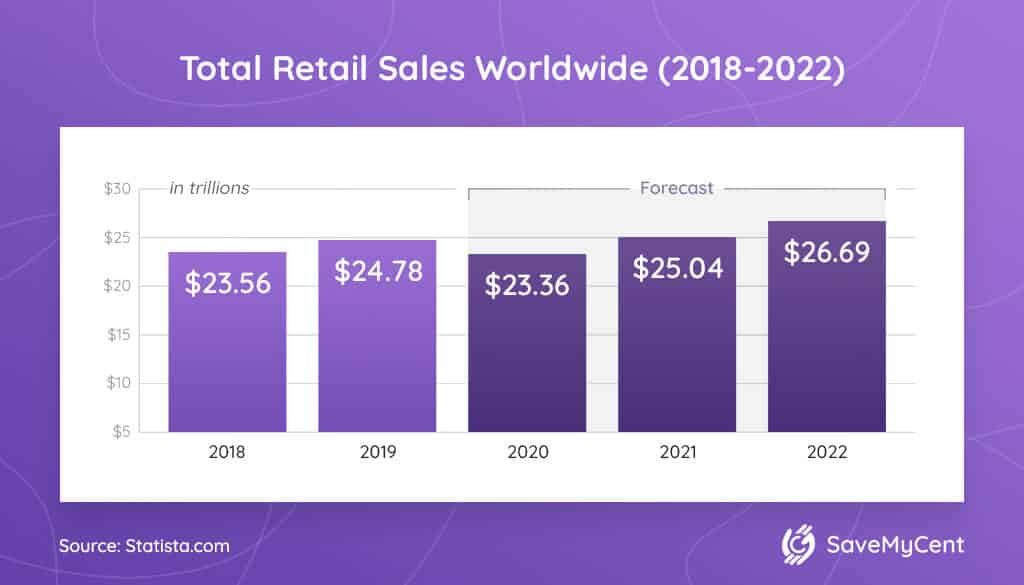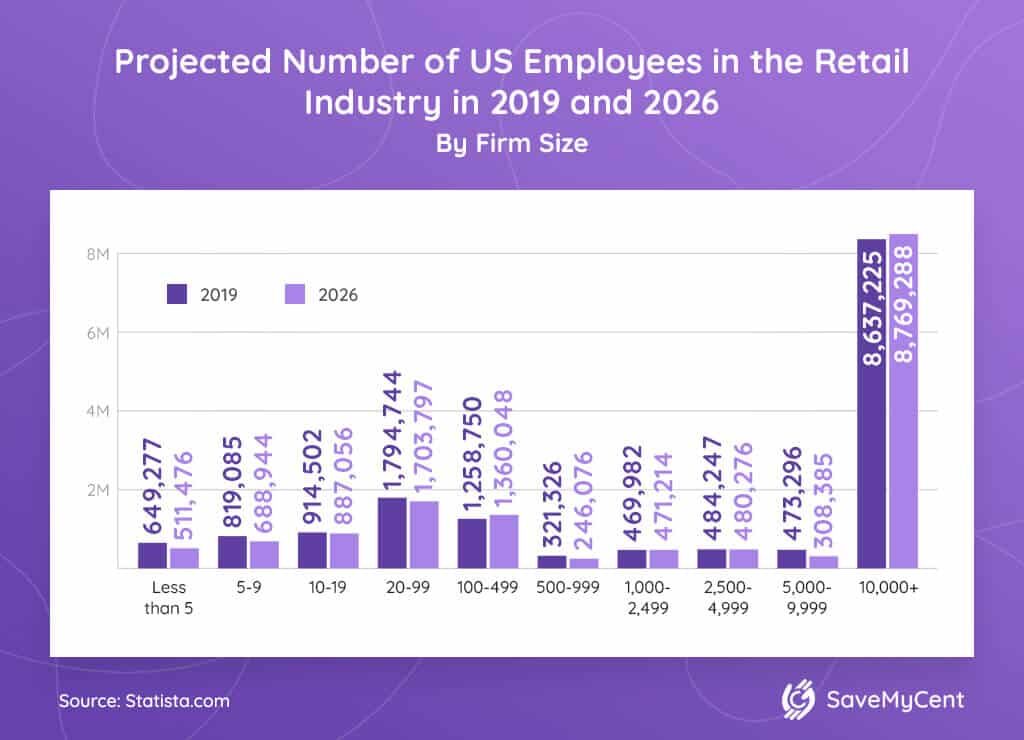Although many claim it’s a dying industry, retail is at the heart of every modern economy, and people worldwide participate in it daily. Because it’s so unavoidable, it’s crucial to stay up to date with the latest developments.
Retail statistics provide important insight into the current state of the market. As such, they represent a valuable source of information that can help you make better decisions and improve your business.
Join us as we explore the most interesting facts and figures for 2021.
Top 10 Important Retail Trends (Editor’s Picks)
- In August 2021, retail sales had a 15.1% growth year-over-year.
- Retail and food service sales were worth $619.1 billion in March 2021.
- In September 2020, there was a $5.2 billion month-over-month increase in new orders for manufactured goods.
- The recorded losses from shoplifting, error, and fraud were estimated at $46.8 billion in 2017 alone.
- 25% of shoplifters are underaged.
- 29 million Americans work in retail.
- Almost 4 million people work as retail salespersons, making them the most numerous in the profession.
- $25,440 is the average retail worker salary, according to retail statistics.
- By 2026, more than 8.7 million US retail workers will work in companies with 10,000 or more employees.
- 4 out of 5 Americans make online purchases.
General Retail Statistics and Projections
1. Retail reports from August 2021 show a 15.1% growth in sales year-over-year.
(The Balance)
Even though the economy was hit hard by the COVID-19 pandemic, retail sales were up almost across the board. According to US retail sales statistics, the retailers with the most significant year-over-year growths include food and beverage stores (5.7%), car dealerships (11%), and garden and building supply chains (6.3%), clothing and accessory (38.8%) and restaurants (31.9%).
2. Retail and food service sales have increased by almost $400 billion between 1992 and 2021.
(Statista)
Retail sales statistics show that monthly sales 29 years ago amounted to just over $150 billion. Today, they’re at almost $620 billion. This growth wasn’t uninterrupted, though.
In 2008 and 2009, the sales were down as a result of the global financial crisis. More recently, in April 2020, there was a sharp decline of more than $100 billion due to the pandemic, but it only took a few months for the sales to recover and continue growing at their usual pace.
3. In September 2020, there was a $5.2 billion month-over-month increase in new orders for manufactured goods.
(US Census Bureau)
According to retail industry statistics, despite the pandemic’s negative effect earlier in the year, new orders for manufactured goods increased to a total of $475 billion between August and September 2020. Transportation equipment led the growth with 4.9% month-over-month.
4. Total global retail sales will reach $26.7 trillion by 2022.

As for global retail sales, statistics indicate constant growth. In 2018, retail sales amounted to $23.6 trillion. However, the latest data suggests that the expected growth for the three-year period ending in 2022 will be about $3.3 trillion.
Retail Theft Statistics
5. The recorded losses from shoplifting, error, and fraud were estimated at $46.8 billion in 2017 alone.
(National Retail Federation)
The retail industry, no matter how necessary and profitable, always suffers losses. If you look at retailer statistics from a 2017 report, you can see that businesses have lost about 1.33% of their sales due to either crime or human error. While this was on par with 2015 and 2016, it’s worrisome that fewer and fewer retailers are investing in technology to prevent these losses.
6. The average loss per shoplifting incident in 2017 was $559.
(National Retail Federation)
Looking at the organized retail crime statistics from the same 2017 report, it’s encouraging to see that the number of losses of more than $1,000 has decreased significantly. Larger losses of $300 or more were the most common and amounted to 48.9% of all reported losses that year.
7. In 2017, shoplifting was the main reason for inventory shrinkage.
(National Retail Federation)
There are several factors that lead to reductions in retail inventory:
- Shoplifting (external)
- Employee theft (internal)
- Administrative and paperwork errors
- Vendor fraud or errors
- Unknown losses
According to the National Retail Federation’s retail statistics from 2017, with a 35.7% share, shoplifting was the main reason for retail inventory shrinkage. In the second place, with a 33.2% share, was employee theft. Interestingly, shoplifting was most common in clothing and apparel stores, where it accounted for 43.1% of all possible sources of inventory shrinkage.
8. 25% of shoplifters are underaged.
(HG.org)
When you look at shoplifting in retail stores statistics, it’s interesting to note that the proportion of male perpetrators is almost equal to that of females. Of the three-quarters of adult shoplifters, 55% claim they first stole something from a retail store while still in their teens.
Retail Employment Statistics
9. 29 million Americans work in retail.
(National Retail Federation)
There are currently about 3.6 million retail stores across the US.
The retail industry represents one of the largest, if not the largest private-sector employer in the US, according to retailing statistics. Between employees and suppliers, this industry supports 42 million jobs nationwide and accounts for $2.6 trillion of the country’s annual GDP.
10. 56.5% of US retail workers are women.
(US Census Bureau)
US Census Bureau’s retailers statistics also show that Hispanics represent 18.7% of all retail workforce, while Blacks comprise 12.5%. In both cases, their representation in the industry is higher than their representation in the total domestic workforce. It’s also interesting to note that more than half of all retail workers are aged 16–34, while only 18.1% hold a university degree.
11. Almost 4 million people work as retail salespersons, making them the most numerous in the profession.
(US Bureau of Labor Statistics)
According to 2019 retail industry facts from the Bureau of Labor Statistics, 3,995,840 employees in retail work as salespersons. Other most common jobs include:
- Cashiers – 2,967,870
- Stock clerks and order fillers – 1,402,230
- First-line supervisors and retail managers – 1,061,850
12. Grocery stores employ 1.3 million workers.
(US Census Bureau)
Of the total number of people employed in retail, most work at grocery stores. Other retailers with the most numerous workforce include:
- General merchandise stores – 865,000
- Clothing stores – 734,000
- Department stores – 535,000
- Building material and supplies dealers – 528,000
13. $25,440 is the average retail worker salary.
(US Bureau of Labor Statistics)
2019 US retail industry analysis shows that retail workers make $12.23 per hour on average. Retail sales jobs are in high demand because they don’t require any formal educational credentials. What’s more, the job outlook for the next 10 years is very positive.
According to projections from the Bureau of Labor Statistics, only about 19,700 retail sales jobs will be lost by 2029. That’s a considerably lower decline than in many other industries.
14. 2018 statistics show that 10.1% of retail workers lived in poverty.
(US Census Bureau)
Retail stats reveal that approximately 1 in every 10 retail workers spent 2018 living in poverty. That’s significantly higher than the total domestic workforce average, which stood at 6% that year. At 16.7%, cashiers were most likely to live below the poverty line. They were closely followed by retail salespeople, with an average poverty likelihood of 9%.
15. The average employment satisfaction rate among US retail workers is 78%.
(National Retail Federation)
According to the National Retail Federation’s retail stats, while 78% of retail workers expressed satisfaction with their current job, 79% said they would describe themselves as happy in their workplace. The same set of stats reveals that 60% of retail workers have been promoted since starting in the industry, whereas 85% have earned a raise at least once in their retail career.
16. By 2026, more than 8.7 million US retail workers will work in companies with 10,000 or more employees.

That accounts for 30% of all currently employed retail workers nationwide, which means that large retail chains will continue to gradually take over small brick-and-mortar stores.
Recent retail industry growth projections suggest that the number of these big companies won’t see any major changes. There are currently 337 such companies in the US, and their number could grow to 340 by 2026. However, smaller retail stores with up to five employees could suffer a massive hit – their number is expected to drop from 357,466 in 2019 to 290,526 in 2026.
Age-Based Retail Trends
17. 60% of millennials would purchase tech from a retailer that nurtures relationships with clients.
(MediaPost)
Most millennials value brands with good customer relationships over those looking to make a quick buck. On that note, 34% of millennials say they only buy tech from brands they have some personal connection with, be it via social media or through their friends’ and family members’ experiences. Also, 26% of them would only buy from tech retailers that share their values.
18. 31% of Gen Xers are buying from big-name tech retailers exclusively.
(MediaPost)
According to a retail trends survey by MediaPost, close to a third of Gen Xers (people born in the 1960s and 1970s) said they would only buy tech products from a big-name retail company. 32% of Baby Boomers (people born between 1946 and 1964) share their opinion.
In contrast, only 23% of millennials stated it’s vital for the brand to have been on the market for 10 years or more when buying tech products.
19. 66% of Baby Boomers shop online.
(Salesfloor)
That’s not to say that Boomers are definitely transitioning to online shopping. According to Colloquy’s retailing statistics report, 84% of Baby Boomers still prefer going to a traditional retail store than shopping online. At the same time, 67% said that even if the product they’re looking to buy was available to purchase online, they’d still opt for the in-store experience.
Online Retail Statistics
20. 4 out of 5 Americans make online purchases.
(Growcode)
Of the 80% of Americans who shop for products online, 50% use their mobile phones to do so. According to Growcode’s 2020 retail industry overview, the US still has some catching up to do compared to Europe. While only 64% of consumers over there opt for online shopping, more than 55% do so from their mobile devices. Industry projections also show that the worldwide mobile payment market will reach a value of close to $3.4 billion by 2022.
21. Mobile ecommerce will hit $3.56 trillion in 2021.
(Oberlo)
According to a US retail sales report, that’s a 22.3% growth year-over-year compared to $2.91 trillion in 2020. Looking at the data from the last few years, mobile ecommerce sales have been growing steadily every year from 2016, when their total value was estimated at just $0.97 trillion.
22. Projected revenue for e-retails is expected to grow to around $6.54 trillion by 2022.
(Statista)
With more and more people choosing online shopping platforms over brick-and-mortar stores, the growth of ecommerce is all but certain in the coming years. Retail statistics reveal that the size of the ecommerce market, which was estimated at $3.53 trillion in 2019, could grow by another $3 trillion over a three-year period ending in 2022.
23. The number of digital buyers is expected to grow to 2.14 billion in 2021.
(Statista)
Retail industry statistics for 2020 suggest that the number of digital customers will continue to grow at its usual pace into the next year. For comparison, the number of global online shoppers has increased by 480 million since 2014, growing steadily by about 68.6 million each year.
24. By 2023, ecommerce will represent 64% of all Chinese sales.
(Growcode)
The growth of ecommerce in China isn’t stopping anytime soon. Growcode’s retail sales report reveals that the most populous country in the world is also the leader in mobile payment. The country’s top two platforms, Alipay and WeChat, currently have around 1 billion users combined.
More Surprising Retail Statistics
25. At least 8,300 US retail stores are expected to close in 2020.
(Business Insider)
The negative trend of closing retail stores, which hit a record of 9,300 in 2019, will continue. According to US retail industry statistics, the total number of retail stores shut down in 2020 could exceed 8,300 and go all the way up to 12,000, which would set a new record. Some of the retailers closing their doors in 2020 include Pier 1 (950 stores), Acena (1,100), and Gap (350).
26. 64% of people will opt for a retail company based on political issues.
(Edelman)
A 2018 Edelman study on retail sales trends showed a 13% increase year-over-year in the number of consumers who choose to buy from a brand or boycott it based solely on their socio-political beliefs. Japan has the most belief-driven buyers (60%), followed closely by the US (59%) and the UK (57%).
Most belief-driven buyers are in the 18–34 age group (69%) and among those with a high income (69%). It’s also interesting to note that 53% of the respondents believe that brands and companies have more power to solve social issues than their countries’ governments.
27. 9% of shoppers are more likely to buy something they don’t need in a physical store.
(Contentsquare)
This is one advantage retail stores have over ecommerce businesses. Retail store statistics also reveal that in-store discounts are still a powerful tool to increase sales, as 5% of shoppers say they might buy discounted items while browsing the store.
As for impulse shopping, physical stores are on par with internet stores. Namely, 76% of in-store shoppers and 79% of online shoppers say they don’t always stick to their shopping list.
28. 80% of consumers are looking up reviews while in a physical store.
(OuterBox)
Although they’re physically in a store, as many as 8 out of 10 consumers look up online reviews on their mobile devices before opting to buy something.
Speaking of mobile devices, retail sales data shows that, for 40% of consumers, all it takes is one negative mobile shopping experience to go to a different retailer. Even more distressing is the fact that 84% of consumers have reported problems with at least one mobile transaction.
29. 46% of shoppers buy to distract themselves when hungry.
(Contentsquare)
Shopping as a form of distraction is classified as stress shopping. Other stress shopping retailer statistics reveal that 18% of people have bought an item out of social awkwardness because they couldn’t say no to the shop assistant. A whopping 61% of shoppers aged 16–24 describe themselves as stress shoppers. Most of them stress-buy food (35%) and clothes (29%).
30. 83% of people feel stressed when being followed by a shop assistant.
(Contentsquare)
At the same time, 79% say that incompetent in-store staff makes them nervous, especially when interrupting them to recommend products they have no interest in. For 85% of shoppers, the biggest in-store stressor is a declined discount voucher or a broken/non-existent credit card machine. Retail shopping statistics also show that 83% of shoppers are stressed out when the inside of a retail store is organized in a way that makes it difficult to browse.
What’s the State of Retail?
The retail industry is essential for the economy of any country. Although many believe it’s slowly dying out, the fact is that retail is responsible for 1 in 4 jobs in the US.
Retail statistics clearly show that technological development is driving the growth in ecommerce, but that doesn‘t necessarily spell the end of traditional brick-and-mortar stores. According to the official data, the job outlook for the retail industry in the next ten years is fairly positive.
As long as physical retailers adjust to the demands of modern-day customers and do all they can to improve their shopping experience, they can continue to thrive in today’s economy.
FAQ
Is retail a dying industry?
Physical retail businesses have experienced a massive hit due to technological developments and the COVID-19 pandemic, but it doesn’t mean that the industry is dying out. Yes, we’re all witnessing the unprecedented growth of ecommerce, especially among younger consumers.
However, the Bureau of Labor Statistics’ projections for the industry are rather positive. In the next ten years, the industry is expected to lose 19,700 sales jobs, but that’s minuscule compared to some other industries and the fact that retail currently employs 29 million people. Although the future is uncertain, retail doesn’t seem to be going anywhere anytime soon.
How much of the US economy is retail?
Retail is an extremely important part of the US economy. According to recent statistics, the industry currently employs 29 million people. With suppliers and all other adjacent workers taken into account, the industry currently supports about 42 million jobs in the US.
As for its value, retail accounts for $2.6 trillion of the annual GDP, which equals 12.7%.
What is an example of a retail business?
Retail involves the sale of goods directly to customers. Goods are exchanged for money, which the retailer receives. The best examples of retail businesses are brick-and-mortar stores. We often refer to them as physical stores to distinguish them from ecommerce platforms.
That’s not to say that ecommerce platforms aren’t retail businesses. After all, most of them also sell goods directly to customers in exchange for money. So, any company that fits the definition of retail but does its business exclusively online can also be classified as a retail company.
What percentage of workers are in retail?
A report from the National Retail Federation shows that there are about 29 million people working in retail and another 13 million working in industries that directly depend upon retail. This means that the industry is currently supporting 42 million jobs, according to retail statistics.
Seeing as 155.67 million people in the US are currently employed, according to a 2018 report, retail jobs account for close to 27% of all US jobs. This would mean that 1 in every 4 jobs in the US is either in retail or some other, closely related industry.
Sources:
- The Balance
- Business Insider
- Contentsquare
- Edelman
- Growcode
- HG.org
- MediaPost
- National Retail Federation
- National Retail Federation
- National Retail Federation
- Oberlo
- OuterBox
- Salesfloor
- Statista
- Statista
- Statista
- Statista
- Statista
- Statista
- Statista
- US Bureau of Labor Statistics
- US Bureau of Labor Statistics
- US Census Bureau
- US Census Bureau
- US Census Bureau







![How to Get Free Clothes From Shein? [2024 Guide]](https://savemycent.com/wp-content/uploads/2023/09/How-to-Get-Free-Clothes-From-Shein-336x220.png)
